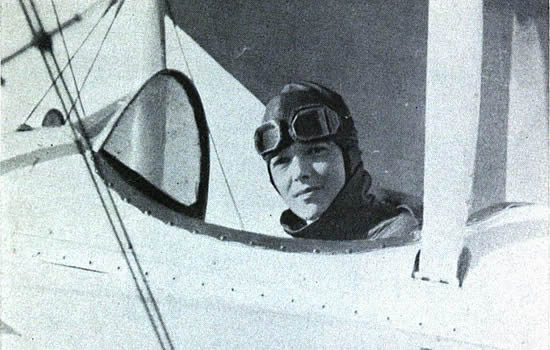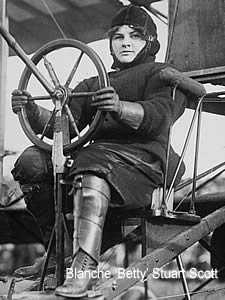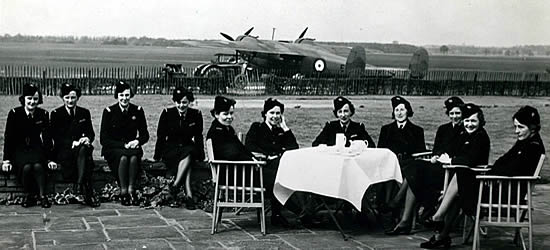A history of high-flying womenArtemis Aerospace |
Women have been taking to the skies since the dawn of aviation, but their contribution isn’t as well-known as it should be. Artemis Aerospace delves into the incredible history of female flyers.

Amelia Earhart in her first training plane in 1920.
If you were asked to name a female aviator, the chances are that the first names to come up would be Amy Johnson, the first woman to fly solo from the UK to Australia, or Amelia Earhart, the first to fly across the Atlantic, both pioneering and record-breaking pilots who caught public imagination and died in their cockpits.
However, women have been taking to the skies unsung right from the beginning of powered flight. We have a look back at some of their achievements . . .
 It's uncertain exactly who the first woman pilot was. Blanche ‘Betty’ Stuart Scott is a candidate, as possibly the first American woman to fly a plane in 1910, although it was an unintentional first. During a flying lesson which was meant to be purely ground-based, Betty’s plane, a ‘Curtiss Pusher’, (a biplane with a three-wheeled undercarriage) was lifted forty feet in the air by a gust of wind, following which she executed a textbook landing. She subsequently became the first woman to take a long-distance flight when she flew 60 miles from New York in a ‘Baldwin Red Devil’.
It's uncertain exactly who the first woman pilot was. Blanche ‘Betty’ Stuart Scott is a candidate, as possibly the first American woman to fly a plane in 1910, although it was an unintentional first. During a flying lesson which was meant to be purely ground-based, Betty’s plane, a ‘Curtiss Pusher’, (a biplane with a three-wheeled undercarriage) was lifted forty feet in the air by a gust of wind, following which she executed a textbook landing. She subsequently became the first woman to take a long-distance flight when she flew 60 miles from New York in a ‘Baldwin Red Devil’.
Another candidate for first female pilot is American Bessica Raiche, who in 1910 made the first accredited solo flight by a woman in the US, piloting a plane constructed with bamboo and silk which she and her husband put together in their sitting room! Then there is the Frenchwoman Raymonde de la Roche, the world’s first woman to earn an aeroplane pilot’s licence in 1910, and Harriet Quimby, who was the first woman to fly solo across the English Channel in 1912.
Following these exploits, increasing numbers of adventurous women began to develop an interest in aviation, and in 1929 an organisation called the Ninety-Nines was founded in New York, with the aim of the advancement of aviation and the creation of a central record of women pilots. Two years later Amelia Earhart was elected the first president, and the group fixed on the name ‘Ninety-Nines’ to represent the 99 current charter members, with membership open to all licenced pilots.
However, it was the Second World War which propelled women more extensively into the skies. In the UK, the women’s section of the Air Transport Auxiliary was set up. This was a civilian organisation which had been formed to shuttle new and repaired aircraft, as well as those in need of repair and maintenance, between factories, maintenance depots and airfields. Other duties included the movement of service personnel, medical supplies and mail. In America, the Women Airforce Service Pilots (WASPs) fulfilled a similar role.

Air Transport Auxiliary | Photo courtesy: Museum & Archive at Maidenhead Heritage Centre.
In 1940, the first eight women joined the ATA and were expected to fly over 15,000 miles a week between them. To begin with they were only permitted to fly Tiger Moths, but gradually this remit widened to meet increasing demand and eventually the women flew every type of aircraft including the Spitfire, Hurricane, Lancaster and even the giant American B17 Flying Fortress.
As the war progressed, the ATA became known as the pilots who would fly ‘from anywhere, to anywhere’. It was part of government policy to disperse new aircraft to thousands of different airfields barely worthy of that name in isolated spots all over the UK, in order that a surprise blitz by the enemy wouldn’t put too many out of action and leave British airspace vulnerable. For example, a Spitfire factory in the West Midlands turned out 320 planes a month at peak production, which needed to be flown to safety as soon as they were finished.
In June 1941, the Aberdeen Press and Journal reports a typical day in the life of an ATA pilot, who would deliver ‘. . . a bomber from an aerodrome in Southern England to Scotland one morning, take over a Hurricane, and deliver it to the West Country by lunch time, fly a general reconnaissance aircraft from there to East Anglia in the early afternoon, and perhaps find there is a four-engined giant to take to Northern Ireland before dusk.’
Throughout the war, the female and male pilots of the ATA transported 309,000 aircraft of 147 different kinds, often in extremely challenging conditions. There was no radio contact, and always the prospect of being caught up in a dogfight with the Luftwaffe if one unexpectedly blew up during the flight. There was a good deal of night flying, taking off and landing from remote unlit fields, and the requirement always to keep the ground in sight in case inclement weather occurred, which was not easy at night in a country under strict blackout conditions. Unlike the RAF, who were trained on a specific aircraft, ATA pilots were expected to turn their hands to whatever they were given. It is worth noting that at a time of considerable inequality in pay between the sexes, ATA women were paid the same as men of equal rank, the first time that the UK government had permitted this in one of its organisations.
After the war, women continued to break barriers in aviation. In 1963 Valentina Tereshkova became the first woman in space. In 1977 ten women became the first to graduate in the US Air Force Pilot Training program – the RAF didn’t follow until 1990. 1987 saw Lynne Barton become British Airways’ first woman pilot, and in 1995 Eileen Collins became the first female pilot of the Space Shuttle.
Fast forward to the present day and women can be found in every sector of the aviation industry; in the cockpit of both military and commercial aircraft, in space, air traffic control, and designing, building and maintaining aircraft. With the current worldwide shortage of qualified pilots, their skills are very much in demand and the UK Civil Aviation Authority is continuing a major campaign to recruit women. Its statistics show that between 2019 and 2023 there was a 26% increase in pilot licences issued to women, with a 43% increase in the number of licences issued to women for commercial flying and 11% for general aviation.
For aspiring women pilots who want to build on the original foundations set by aviators such as Amy Johnson, Amelia Earhart and the many other pioneers, it’s exciting to know that the sky is no longer the limit.
 |
Artemis Aerospace offers an innovative approach to component solutions for the aviation sector. Established in 1999, the company has earned a reputation for outstanding customer service by solving problems and providing a range of realistic options that offer customers the flexibility and freedom to choose a solution that suits their timescale and budget. Its services include component supplies, component repairs, lessor support, flight simulation hardware support, consignment stock management and global aircraft logistics.
With decades of expertise in global aviation logistics, the expert team works with trusted MROs, OEMs, and aftermarket suppliers around the world to offer 24/7 support to its global customer base.





